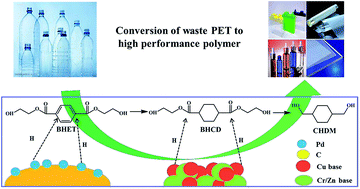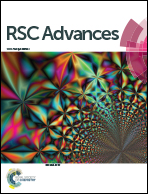Preparation of 1,4-cyclohexanedimethanol by selective hydrogenation of a waste PET monomer bis(2-hydroxyethylene terephthalate)
Abstract
A new approach is developed for the preparation of 1,4-cyclohexanedimethanol (CHDM) by hydrogenation of bis(2-hydroxyethylene terephthalate) (BHET) obtained from waste poly(ethylene terephthalate) (PET). The influences of various reaction parameters including temperature, pressure and time, on the hydrogenation reaction were studied, and the 100% conversion of BHET and 78% yield of CHDM were achieved with Pd/C and Cu-based catalysts. X-ray diffraction, low temperature N2 adsorption–desorption and H2 temperature-programmed reduction were used to characterize the Cu-based catalysts, demonstrating that the Cu+/Cu0 species are the active sites. This study not only provides a new route for the production of CHDM, but also an approach for the efficient utilization of waste PET.


 Please wait while we load your content...
Please wait while we load your content...